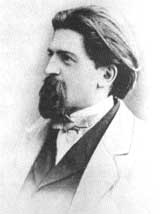| Join the International Draeseke Society and receive a substantial discount on your order. |
AK|Coburg Recordings International Draeseke Society/NA - Box 104, Sand Lake, NY 12153 USA |
Felix
Draeseke was born in 1835 in the Franconian ducal town of Coburg, Germany. He was early attracted to music and encountered no
opposition from his family when, in his mid-teens, he declared
his intention of becoming a professional musician. A few years
at the Leipzig conservatory did not seem to benefit his development,
but During his
career Draeseke divided his efforts almost equally among compositional
realms. Already with his early (and only) Piano
Sonata in C# minor (Sonata quasi Fantasia) of 1862-1867 he aroused
major interest, winning Liszt's unreserved admiration of it as
one of the most important piano sonatas after Beethoven. His operas "Herrat" (1879,
originally "Dietrich von Bern") and "Gudrun" (1884,
after the medieval epic of the same name) met with some success,
but their subsequent neglect has kept posterity from understanding
Draeseke as one of the few true successors to Wagner and one of
the very few who could conceive dramatically convincing and musically
compelling examples of "Gesamtkunstwerk". A master contrapuntist,
Draeseke reveled in writing choral music, achieving major success
with his B minor Requiem of 1877-1880, but nowhere proving more
convincingly his powers in this direction than in the staggering
Mysterium "Christus" which is comprised of a prolog and
three separate oratorios and requires three days for a complete
performance, a work which occupied him between the years 1894-1899
but whose conception reaches back to the 1860s. Of all the symphonies
from the second half of the 19th century which are today neglected, Draeseke's "Symphonia Tragica" (Symphony No. 3 in C major,
Op.40) is one of the very few which deserves repertory status alongside
the symphonies of Brahms and Bruckner, a masterful fusion of intellect
and emotion, of form and content. Orchestral works like the Serenade
in F major, Op. 49 (1888) or its companion of the same year, the
symphonic prelude after Kleist, "Penthesilea", have in
them all that is declared necessary for audience success: rich
melodic invention, rhythmic vivacity and extraordinary harmonic
conception. Draeseke's production was equally rich in chamber music
and there in recent years the composer has perhaps attracted the
most immediate attention, if primarily because of the performance
forces required. Reissues of the scores and parts to the B flat
major Clarinet Sonata (1887), the E minor String Quartet (No.2,
1887 as well) and the F major String Quintet (Op. 77 of 1900, featuring
two 'celli ) have been performed worldwide. An ever widening audience
seems to be developing for Draeseke at last and the phenomenon
is based on perception of individuality, inventiveness and stylistic
integrity, music which truly rewards attention. |
The following works of Felix Draeseke are available on AK/Coburg (click on any work to see details about that recording):
More information on Felix Draeseke is available at the Draeseke Societies Home Page: www.draeseke.org |

 after one of the early performances of Wagner's "Lohengrin" he
was won to the camp of the New German School centered around Liszt
at Weimar, where he stayed from 1856 (arriving just after Joachim
Raff's departure) to 1861. Following the debacle concerning Peter
Cornelius' opera "The Barber of Baghdad" and its resultant
consequences for Liszt and his circle, Draeseke made his way to
Switzerland where he remained until 1876, teaching in the Suisse
Romande in the area around Lausanne. Upon his return to Germany
Draeseke chose Dresden as his place of residence: though he continued
having success with his compositions, it was only in 1884 that
he received an official appointment to the Dresden conservatory
and with it, some financial security. In 1894, two years after
his promotion to a professorship at the Royal Saxon Conservatory,
Draeseke at the age of 58 married his one-time pupil Frida Neuhaus;
the marriage was by all accounts, harmonious and most successful,
a blessing for him till his death in 1913.
after one of the early performances of Wagner's "Lohengrin" he
was won to the camp of the New German School centered around Liszt
at Weimar, where he stayed from 1856 (arriving just after Joachim
Raff's departure) to 1861. Following the debacle concerning Peter
Cornelius' opera "The Barber of Baghdad" and its resultant
consequences for Liszt and his circle, Draeseke made his way to
Switzerland where he remained until 1876, teaching in the Suisse
Romande in the area around Lausanne. Upon his return to Germany
Draeseke chose Dresden as his place of residence: though he continued
having success with his compositions, it was only in 1884 that
he received an official appointment to the Dresden conservatory
and with it, some financial security. In 1894, two years after
his promotion to a professorship at the Royal Saxon Conservatory,
Draeseke at the age of 58 married his one-time pupil Frida Neuhaus;
the marriage was by all accounts, harmonious and most successful,
a blessing for him till his death in 1913.